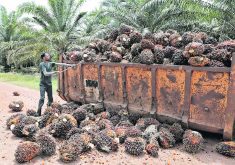Sustainable aviation fuel is preparing for takeoff and that could have big ramifications for the vegetable oil sector.
Renewable diesel has been getting a lot of press lately, but the less ballyhooed sustainable aviation fuel (SAF) could be equally exciting, said Ian Thomson, president of Advanced Biofuels Canada.
The United States has set a target of having at least 11 billion litres of SAF production per year by 2030.
U.S. President Joe Biden recently announced a SAF tax credit as part of his build back better agenda. And there are US$4.3 billion in government funding opportunities for the fledgling sector.
Read Also

Phosphate prices to remain high
Phosphate prices are expected to remain elevated, according to Mosaic’s president.
The SAF market is projected to grow to $15.3 billion by 2030 up from $66 million in 2020, according to a report published by Markets and Markets.
Thomson said SAF has the potential to be as big a new source of demand for soybean oil and canola oil as renewable diesel.
Fred Ghatala, director of carbon and sustainability at Advanced Biofuels Canada, had a different way of stating the potential.
“Imagine if biodiesel and ethanol were starting with acceptance of up to 50 percent blends,” he said.
The fuel has already been thoroughly vetted by the airline industry and has approval to be distributed through airport pipeline infrastructure.
“You’ve really got a situation where they could expand very rapidly,” said Ghatala.
Chris Vervaet, executive director of the Canadian Oilseed Processors Association, agrees that there is “a lot of potential” in the U.S. market and he hopes that will be the case in Canada as well.
“At the moment in Canada we don’t see a lot of incentives out there to make sustainable aviation fuel commercially feasible,” he said.
“We’re a little bit behind here in Canada.”
He would like to see tax credits and other incentives similar to what Biden’s administration is offering south of the border.
Vervaet hopes there is something embedded in Canada’s Clean Fuel Regulations and in provincial policies, such as British Columbia’s Low Carbon Fuel Standard, to help promote SAF.
There are no SAF mandates in either the U.S. or Canada. Thomson thinks that is a matter of time.
The hope is that the incentives being offered by the Biden administration generate increased production of the alternative fuel and that in turn could eventually lead to mandates.
“They’re going to happen. The writing is on the wall,” he said.
In the meantime, there appears to be an appetite to use the product on a voluntary basis.
United Airlines became the first commercial carrier to fly an aircraft full of passengers using 100 percent SAF on Dec. 1, 2021. The flight was from Chicago to Washington.
United’s chief executive officer Scott Kirby called it an “historic moment for global aviation” and said SAF is a better alternative than batteries for reducing the company’s carbon footprint.
“There’s simply no battery technology, even theoretical technology, that has enough energy density that you could put enough batteries on the airplane to get an airplane this big with this many people flying this far,” he said in a news release.
“And so, what works in a lot of other transportation industries won’t work for aviation.”
United recently agreed to buy 5.7 billion litres of SAF from Alder Fuels and has the option to purchase another 3.4 billion litres from Fulcrum BioEnergy.
Thomson believes used cooking oil and animal fats will be the first feedstock choices for SAF manufacturers followed by soybean and canola oil.
Ghatala said the feedstock choice will be highly dependent on the jurisdiction. The European Union is outlawing crop-based SAF but that won’t likely be the case in North America.
The Biden administration has set a target of reducing aviation emissions by 20 percent by 2030. The industry is responsible for 11 percent of U.S. transportation-related emissions.
Thomson said the aviation industry has “a bigger hill to climb” than other transportation related industries when it comes to biofuel due to the lack of mandates and the fact that aviation kerosene sells for less than diesel fuel.
Another issue is that the production process doesn’t yield as much fuel as the renewable diesel process.
And SAF must be able to perform at temperatures below -50 C.
“Anybody who looks at the little map on their Air Canada flight will realize it’s frigging cold out at 32,000 feet,” said Thomson.
















